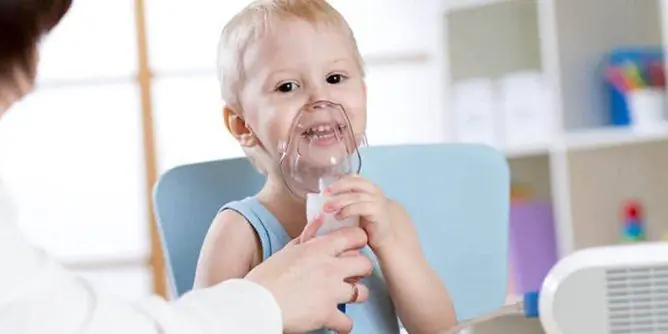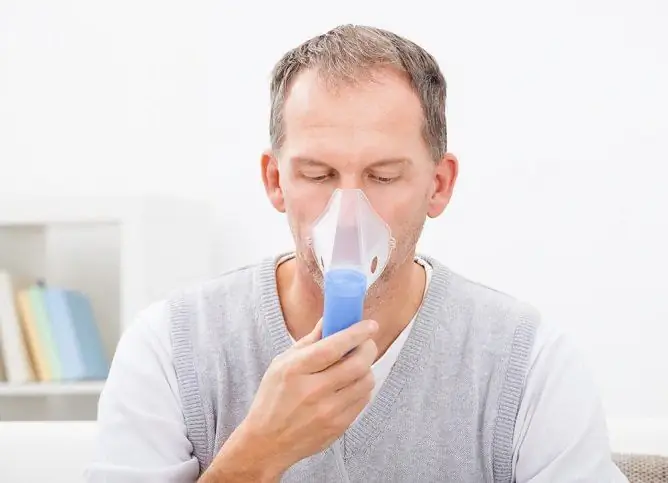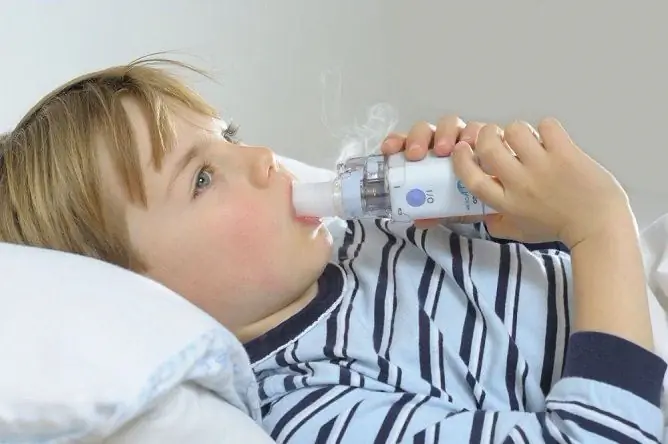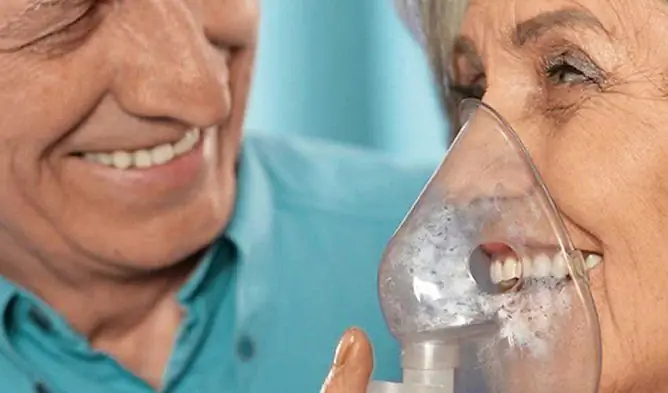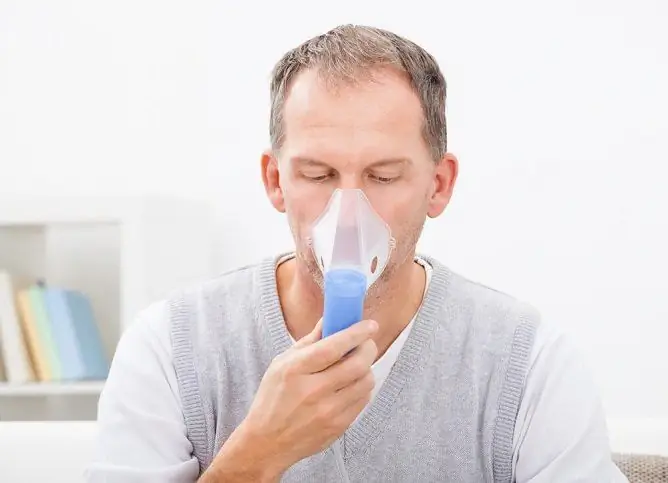- Author Rachel Wainwright [email protected].
- Public 2023-12-15 07:39.
- Last modified 2025-11-02 20:14.
Inhalation with laryngitis with a nebulizer: drugs, rules
The content of the article:
- Inhalation for laryngitis at home: rules for the procedure
-
Preparations for inhalation and features of their use
What solutions are used for steam inhalation
- Video
Inhalation with laryngitis occupies a special place in the complex therapy of the disease. Along with conservative treatment, the correct implementation of such procedures in children and adults allows you to stop the symptoms of pathology within a short period.

The use of a nebulizer allows you to quickly stop the symptoms of laryngitis
Inhalation is a method of administering drugs that is based on the inhalation of gas, vapor or smoke. This method of application makes it possible to reduce the absorption time, provides a selective effect of the active substance on the respiratory system, thereby achieving a local and resorptive effect.
Inhalations can be performed at home, but what to do with them - medicines, alkaline solutions or herbal decoctions, determines the otolaryngologist. This is due to the fact that only a doctor can establish whether it is possible to do inhalations with laryngitis in each specific case, taking into account the patient's condition and the cause of the disease.
The main goals of inhalation therapy are:
- liquefaction of discharge from the nose, pharynx and larynx;
- moisturizing the mucous membrane of the respiratory tract;
- providing mucolytic and antibacterial effect;
- improvement of blood supply and microcirculation in the mucous membrane of the laryngopharynx for faster tissue regeneration;
- reduction of laryngeal edema;
- symptomatic action: reduction of sore throat, irritation and hoarseness;
- prevention of laryngo- and bronchospasm;
- reduction of inflammation;
- prevention of the development of complications - bronchitis and tracheitis.
Inhalation can be:
- cold: carried out using special devices - a nebulizer, compressor inhaler;
- hot (steam): performed using a container with hot liquid.

Steam inhalations can be carried out in the absence of concomitant inflammatory processes - tonsillitis, sinusitis, sinusitis
As means for cold-type procedures, only special purified pharmaceutical medicinal solutions or mineral water are used; oil and herbal decoctions are not suitable for this purpose. It should be borne in mind that conducting a hot type of inhalations is contraindicated in the presence of concomitant inflammatory processes of a purulent nature - tonsillitis, sinusitis, sinusitis. In such cases, warming up promotes faster growth of pathogenic microorganisms and their penetration into the deep parts of the respiratory system.
Inhalation for laryngitis at home: rules for the procedure
It is important to familiarize yourself with the general recommendations for inhalation before starting therapy, namely:
- the duration of the procedure should be at least 5 minutes and no more than 15 minutes;
- inhale through the mouth, exhale through the nose;
- breathing should be calm, free, but shallow.
After eating, at least 1-2 hours should pass. It is not recommended to talk during and half an hour after inhalation. The minimum interval with physical activity is half an hour. During the 30 minutes before and after inhaling cold or hot air, do not drink liquids or smoke.
Patients for whom the doctor prescribed several medicines at once for inhalation should use them in the following sequence:
- bronchodilator drugs;
- expectorants: after 15 minutes;
- antiseptic and anti-inflammatory solutions: after sputum waste.

Before the procedure, it is necessary to fill the working container of the nebulizer with a solution
The working container of the nebulizer is filled with liquid in a volume of 2 to 5 ml, after which a tube is connected to the device, and the mask included in the kit is connected to it. Before the procedure, you should set the level of dispersion of the solution recommended by the otolaryngologist. In most cases, a medium level is sufficient so that the aerosol is not too finely dispersed. Then the device turns on, a mask is pressed to the face, and the patient takes a deep breath. At the end of the procedure, the tube and mask are rinsed under running water.
How many days to do inhalations, as well as the exact dosage of drugs, is prescribed by the doctor on an individual basis.
Preparations for inhalation and features of their use
In order to avoid the development of allergic reactions and bronchospasm, children are not recommended to inhale the vapors of essential oils and medicinal herbs. It is safer to carry out a cold type of procedure for this purpose by means of a nebulizer.

For inhalation, slightly alkaline waters can be prescribed, for example, Borjomi
After consultation with a doctor, as a means for inhalation in patients over the age of 18, the following can be used:
- Lazolvan: a solution that contains the active ingredient - ambroxol hydrochloride. It helps to eliminate the symptoms of the disease, has a thinning phlegm and expectorant effect. It is used in combination with other means, since it cannot completely stop the signs of pathology;
- A solution of epinephrine with saline (in the ratio of 1: 6 and 1: 12): an effective agent for the treatment of laryngitis, but it can cause side effects from the cardiovascular system. Its use is possible only in the absence of direct contraindications;
- Dexamethasone: A fast-acting drug that can be used to provide first aid in critical conditions, for example, during a choking attack. Effectively eliminates wet cough and enhances sputum separation in dry cough;
- Saline solution: used in combination with other drugs, since it is not technically a therapeutic agent. In the initial stages, laryngitis effectively relieves inflammation, moisturizes the mucous membrane of the pharynx and eliminates pain;
- Hydrocortisone: A glucocorticosteroid with antihistamine properties. Effectively relieves swelling, laryngospasm and inflammation in the throat, retains interferon in the body, thereby accelerating the healing process;
- Borjomi, Narzan: slightly alkaline waters, which, when inhaled, moisturize the mucous membrane of the respiratory tract and promote the excretion of phlegm.
Inhalation with laryngitis with a nebulizer in children can be performed from the age of 1 year. According to the doctor's prescription, the following solutions can be used:
- Dekasan: an agent with fungicidal, antibacterial and antibacterial properties. It is used for laryngitis caused by pathogenic microflora;
- Berodual: a drug with a pronounced bronchodilator effect, effectively relieving inflammatory processes. Children are prescribed only in extreme cases, when there are attacks of laryngitis with life-threatening stenosis;
- Fluimucil: a drug that has mucolytic, expectorant and antioxidant effects. Virtually no side effects and can be used as monotherapy;
- Pulmicort: an inhaled glucocorticosteroid with an anti-inflammatory effect. Effectively reduces the severity of symptoms, sputum production, mucus production, hyperreactivity and the frequency of exacerbations of respiratory diseases.
Also, inhalations in children, as in adults, can be carried out with Dexamethasone, Lazolvan, saline and mineral water.

Lazolvan can be used both in the treatment of adults and children.
There are contraindications to carrying out procedures by means of a nebulizer, namely:
- diseases of the cardiovascular system in severe form;
- high blood pressure;
- tendency to nosebleeds;
- increased body temperature (more than 38 ° C);
- the presence of purulent inflammatory processes;
- an aggravated form of asthma;
- breathing disorders.

Ingalipt is often prescribed in addition to inhalation
Along with inhalations, according to reviews, with laryngitis, the use of the antiseptic and anti-inflammatory drug Ingalipt is effective. They irrigate the oral cavity - keep the product in the mouth for several minutes.
What solutions are used for steam inhalation
For this type of procedure, you can use a kettle, bowl, or small pot that is filled with liquid. During inhalation, cover the head with a large towel.
You need to breathe evenly, as usual, without deep breaths and prolonged exhalations. A boiling solution cannot be used for procedures.

For steam inhalation, herbal infusions can be used
The following solutions are used as solutions:
- infusions of medicinal herbs - oregano, juniper, peppermint, chamomile, calendula, St. John's wort, sage, wild rosemary, pine buds, eucalyptus leaves, coltsfoot and raspberry: a decoction of plant materials is prepared half an hour before the procedure. For example, flowers of chamomile, sage, oregano and coltsfoot are mixed, 1 tbsp. a spoonful of such a mixture is poured with 200 ml of hot water and insisted for 30 minutes. Then add boiling water to the resulting liquid, pour it into a container and breathe for 10-15 minutes;
- essential oils - pine, eucalyptus, thuja, juniper, tea tree, Altai or Himalayan cedar: this remedy can only be used in the absence of allergies. 3-5 drops of any of these oils are added to 250-300 ml of hot, but not boiling water and the vapor is inhaled;
- saline solutions: 3 tbsp. tablespoons of sea salt are diluted in 1 liter of hot water, 1 teaspoon of soda is added;
- garlic juice: 2 cloves of garlic are squeezed until juice is obtained, it is diluted in 500 ml of hot water. The finished solution has a pronounced antiseptic and antimicrobial effect.
Video
We offer for viewing a video on the topic of the article.

Anna Kozlova Medical journalist About the author
Education: Rostov State Medical University, specialty "General Medicine".
Found a mistake in the text? Select it and press Ctrl + Enter.

